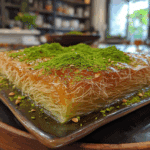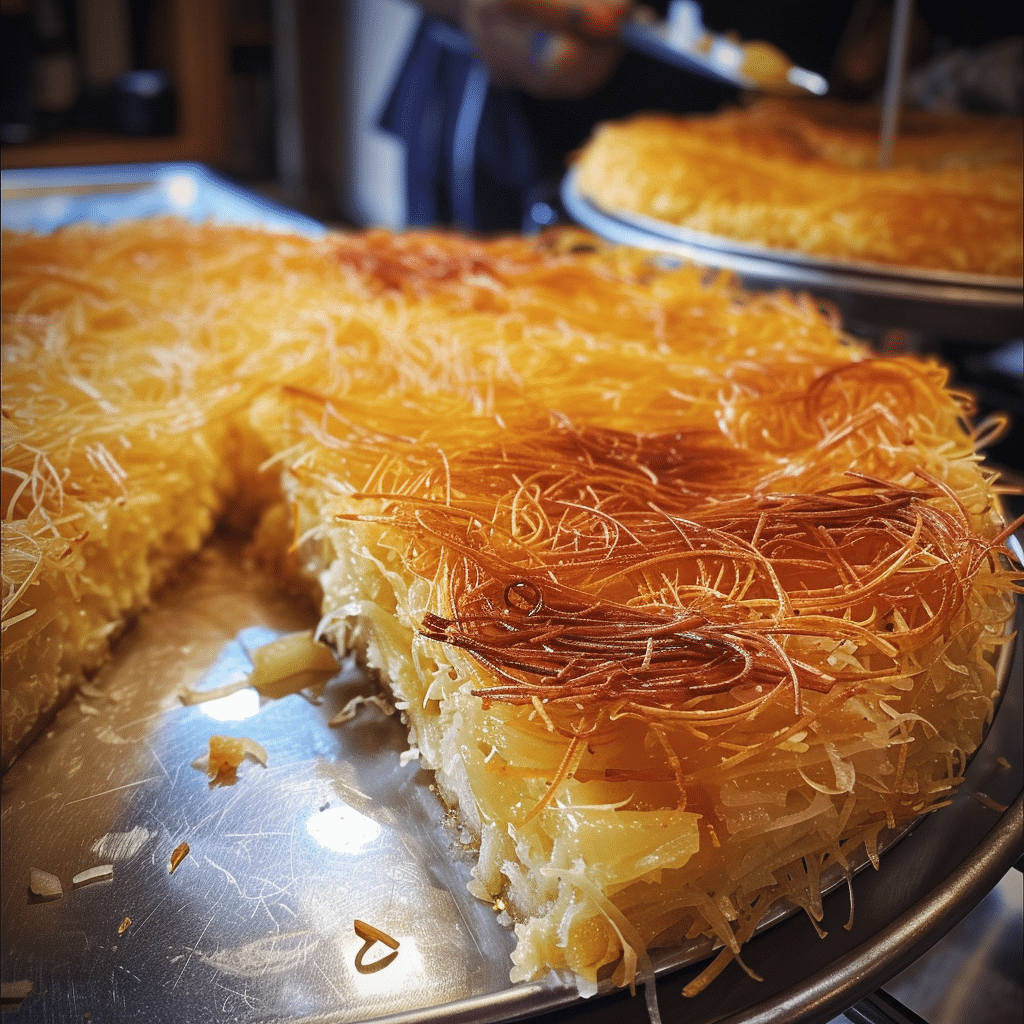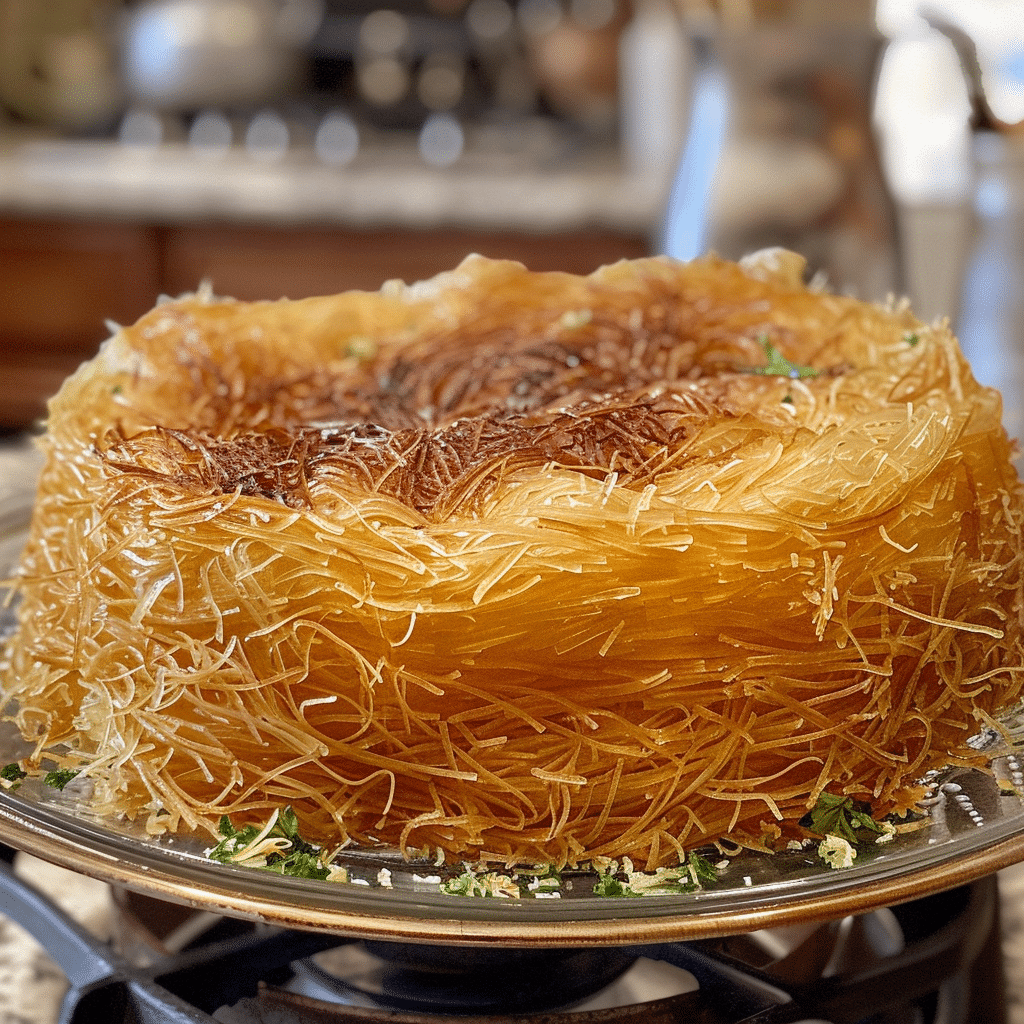If you’re craving a traditional Greek dessert that’s rich, crisp, and dripping with honey syrup, this Greek Kataifi Recipe is the one to try. Made with shredded phyllo dough wrapped around a spiced nut filling and soaked in fragrant syrup, Kataifi is a true showstopper. I tried making this at home for the first time, and the results were incredible—golden, crunchy layers on the outside, and a tender, sweet interior with hints of cinnamon and clove. It’s the kind of dessert that looks impressive yet is surprisingly simple to make once you get the technique down.
Why You’ll Love This Recipe
This Greek Kataifi Recipe delivers everything you love about classic Mediterranean pastries: crisp texture, buttery flavor, and that perfect balance of sweetness. The shredded phyllo (kataifi dough) bakes into delicate golden strands that contrast beautifully with the rich nut filling inside. The honey-lemon syrup adds a luscious finish that soaks just enough into the pastry without making it soggy. It’s a festive dessert often served at celebrations, but it’s also perfect for any time you want to treat yourself to something elegant and truly authentic.
Print
Greek Kataifi Recipe – Crispy, Buttery, and Delightfully Sweet
- Total Time: 1 hr 30 mins
- Yield: 16 pieces
- Diet: Vegetarian
Description
Greek Kataifi is a traditional Mediterranean dessert made with shredded phyllo dough, a rich nut filling, and a fragrant honey-lemon syrup. Golden, crisp, and delicately sweet, this pastry is a cousin to baklava and a favorite treat for holidays and special occasions.
Ingredients
- 1 lb (450g) kataifi dough (shredded phyllo)
- 1 cup (230g) unsalted butter, melted
- 2 cups (200g) walnuts or pistachios, finely chopped
- 1 tsp ground cinnamon
- 1/4 tsp ground cloves (optional)
- 2 tbsp granulated sugar
- For the Syrup:
- 1 1/2 cups granulated sugar
- 1 cup water
- 1/2 cup honey
- 1 tbsp lemon juice
- 1 strip lemon peel
- 1 small cinnamon stick
Instructions
- Preheat oven to 350°F (180°C). Grease a 9×13-inch (23×33 cm) baking dish with melted butter.
- In a bowl, mix chopped nuts, cinnamon, cloves (if using), and 2 tbsp sugar. Set aside.
- Carefully pull apart the kataifi dough with your fingers to loosen and separate the strands.
- Take a small handful of kataifi dough (about 2 tablespoons) and spread it flat. Place about 1 tablespoon of the nut mixture at one end and roll it up tightly into a log. Place seam-side down in the prepared baking dish.
- Repeat with remaining dough and filling until the dish is filled.
- Drizzle or brush the melted butter evenly over all the kataifi rolls, making sure every piece is well coated.
- Bake for 50–60 minutes, or until golden and crisp.
- While the kataifi bakes, prepare the syrup: In a saucepan, combine sugar, water, honey, lemon peel, lemon juice, and cinnamon stick. Bring to a boil, then reduce heat and simmer for 8–10 minutes. Remove from heat and discard peel and cinnamon stick. Let cool slightly.
- When kataifi is done, remove from oven and immediately pour the warm syrup evenly over the hot pastry.
- Allow to soak for at least 1 hour before serving so the syrup is absorbed.
Notes
- Always pour warm syrup over hot kataifi (or vice versa) — this keeps it crisp.
- Store covered at room temperature for up to 5 days; do not refrigerate as it may soften.
- For variety, use pistachios, almonds, or a mix of nuts.
- Prep Time: 30 mins
- Cook Time: 1 hr
- Category: Dessert
- Method: Baked
- Cuisine: Greek
Ingredients
(Tip: You can find the complete list of ingredients and their measurements in the recipe card below.)
Kataifi Dough (Shredded Phyllo): Found in the freezer section of most international or Mediterranean markets.
Unsalted Butter: Melted and used to brush the dough for that signature golden crispiness.
Walnuts and Almonds: Traditional filling ingredients—rich, nutty, and perfectly crunchy.
Sugar: Adds sweetness to both the filling and syrup.
Cinnamon: Gives warmth and depth to the nut mixture.
Cloves (optional): A classic Greek spice that enhances the aromatic flavor.
Lemon Juice and Zest: Balances the sweetness in the syrup and adds freshness.
Water: Used to make the syrup base.
Honey: A key ingredient in Greek desserts—adds natural sweetness and a floral note.
Vanilla Extract (optional): For an extra layer of flavor in the syrup.
Crushed Pistachios (optional): For garnish and a pop of color.
Directions
Step 1: Prepare the Syrup
In a saucepan, combine water, sugar, honey, lemon juice, and zest. Bring to a gentle boil over medium heat, then simmer for 10 minutes until slightly thickened. Remove from heat, add vanilla if desired, and let the syrup cool completely. (The syrup should be cool when poured over the hot pastry.)
Step 2: Make the Filling
In a bowl, combine finely chopped walnuts and almonds with sugar, cinnamon, and cloves. Mix well to evenly distribute the spices.
Step 3: Prepare the Kataifi Dough
Preheat your oven to 350°F (175°C). Gently unroll the kataifi dough, pulling apart and fluffing the strands with your fingers. Keep it covered with a damp towel as you work to prevent it from drying out.
Step 4: Assemble the Kataifi
Take a small handful of kataifi strands (about the size of your hand) and place a tablespoon of the nut filling at one end. Roll tightly into a log or nest shape. Place seam-side down in a greased baking dish. Repeat with remaining dough and filling until the dish is full.
Step 5: Butter and Bake
Generously brush the tops and sides of each kataifi roll with melted butter. Bake for 45–50 minutes, or until golden brown and crispy.
Step 6: Add the Syrup
Once baked, remove the kataifi from the oven and immediately pour the cooled syrup evenly over the hot pastries. Let the dessert sit at room temperature for at least 2 hours to absorb the syrup and develop its signature texture.
Step 7: Garnish and Serve
Sprinkle with crushed pistachios or extra cinnamon before serving. Serve at room temperature with a cup of Greek coffee or tea for the perfect finish.
Equipment needed :
Must-Have Tools to Get Rolling
Here’s what you’ll want to have on hand:
Silicone Spatula – Durable, heat-resistant silicone spatula perfect for mixing, scraping, and spreading. Gentle on non-stick cookware and easy to clean.
Large pot – You’ll need this to boil the whole cabbage head and soften the leaves.
large bowl –Spacious, durable large bowl ideal for mixing, serving, or food preparation. Made from sturdy material and easy to clean.
Sharp knife – For coring the cabbage and slicing out the thick stem in each leaf. A paring knife works best.
Mixing bowl – A big bowl makes it easier to combine your meat and rice filling evenly.
Cutting board – For prepping cabbage leaves and rolling them like a pro.
9×13-inch baking dish – Ideal size to fit your rolled cabbage leaves snugly and prevent them from unraveling.
knife – A sharp, durable kitchen knife perfect for slicing, chopping, and dicing with ease.
Servings and timing
This recipe makes 12–15 kataifi rolls.
Prep time: 25 minutes
Cook time: 50 minutes
Resting time: 2 hours
Total time: About 3 hours (including resting)
Perfect for serving 10–12 people as a dessert.
Storage/reheating
Store your Greek Kataifi at room temperature in an airtight container for up to 5 days. Do not refrigerate, as it can cause the pastry to lose its crispness. For longer storage, freeze before adding syrup, then thaw and bake before serving. To refresh, warm slightly in the oven for 5–10 minutes.

Variations and Customizations
Pistachio Kataifi: Use only pistachios for a vibrant green, nutty version.
Chocolate Drizzle Kataifi: Drizzle melted dark or milk chocolate over the cooled rolls for extra indulgence.
Orange Blossom Syrup: Replace lemon juice with orange blossom water for a floral twist.
Mini Kataifi Nests: Shape the dough into small nests, fill with nuts, and drizzle syrup over the top.
Cream-Filled Kataifi: Add a layer of custard or sweet cream in the middle for a rich variation.
Baklava-Inspired Kataifi: Layer the kataifi with nuts and syrup instead of rolling for a casserole-style dessert.
Coconut Kataifi: Mix shredded coconut with the nuts for extra texture and tropical flavor.
Vegan Version: Use plant-based butter and replace honey with agave or maple syrup.
Cardamom Spice: Add a pinch of cardamom for an aromatic Middle Eastern touch.
Holiday Edition: Garnish with pomegranate seeds and gold leaf for festive presentation.
FAQs
1. What is kataifi dough made of?
Kataifi dough is made from thin, shredded phyllo pastry—light, delicate, and crisp when baked.
2. Can I use regular phyllo dough instead?
You can, but it won’t have the same texture. Regular phyllo is layered, while kataifi is shredded.
3. Where can I buy kataifi dough?
Look for it in the frozen section of Greek, Middle Eastern, or international grocery stores.
4. Can I make the syrup ahead of time?
Yes, prepare it up to 3 days in advance and store it in the fridge until ready to use.
5. Why does my kataifi turn soggy?
Adding syrup while both the pastry and syrup are hot causes sogginess—always pour cool syrup over hot pastry.
6. Can I use different nuts?
Yes, walnuts, almonds, and pistachios are traditional, but hazelnuts or pecans also work.
7. How do I re-crisp leftovers?
Reheat in a 325°F (160°C) oven for 5–7 minutes before serving.
8. Can I skip the honey in the syrup?
Yes, replace it with sugar syrup alone, though honey adds authentic Greek flavor.
9. Can I make this dessert ahead of time?
Yes, it tastes even better the next day as the syrup settles.
10. What should I serve with kataifi?
It pairs beautifully with vanilla ice cream, whipped cream, or Greek yogurt.
Conclusion
This Greek Kataifi Recipe is a masterpiece of flavor and texture—crispy, nutty, buttery, and soaked in aromatic honey syrup. Each bite delivers the perfect balance of sweetness and crunch, making it a dessert that’s both traditional and timeless. Whether you’re preparing it for a celebration or simply want to enjoy a taste of Greece at home, this kataifi will make you fall in love with Mediterranean pastries all over again. Serve it proudly—it’s a sweet that truly shines.

